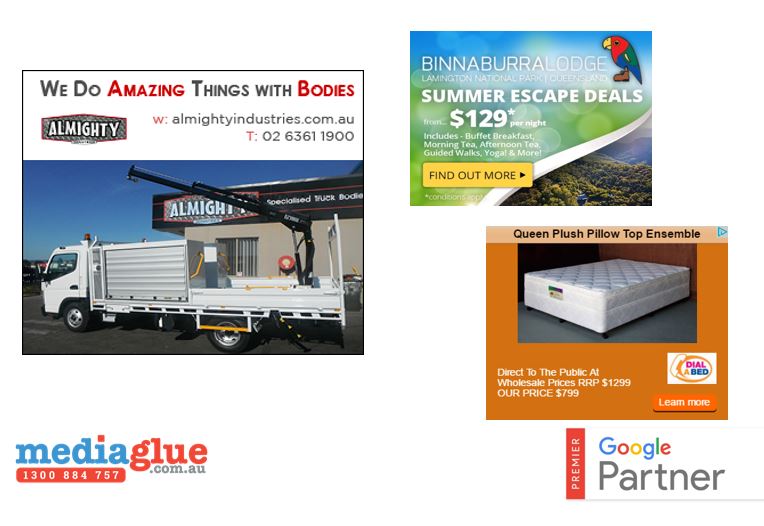Advertising Essentials: What’s Right For Your Business?

The purpose of business is to make a profit. The purpose of a website is to convert a visitor to an enquiry and the purpose of Advertising is to bring qualified traffic (aka potential purchasers) to the website to learn more.
Let’s look at the three main types of advertising used with Google Ads, Search, Display and Shopping.
Search is putting a short snippet of text in front of someone actively searching for your product or service. It needs to be engaging and compelling to the person you are wanting to attract.
These Ads typically appear above Organic listings and to the left of the Google Maps listings. They also have a very faint ‘Ad’ in the top left hand corner.
Ideally you want paid, organic and the maps listing. Why? You are maximising your real estate on the SERP (Search Engine Results Page), increasing your visibility and your credibility.
And because it is so often overlooked, I’ll just mention it’s also important you have a robust list of negatives, those terms you don’t want to be found for. On this point I can’t stress enough how important regular maintenance is, look at it like weeding, if they are left to grow they completely take over and every click on a bad search term is an opportunity cost on a quality search term. Over a few months this can add up to many thousands of dollars, attended to regularly you might only pay for one or two of those clicks, left to grow and fester you can burn through money and this is one of the reasons people say ‘Google Ads Don’t Work’. Google Ads work really well, like anything valuable your Google Ads campaign needs to be well maintained.
And while we are on the subject 15 years ago it wasn’t that difficult to put together a reasonable performing campaign. Today not only is competition stiffer, the platform is a monster and if you aren’t trained all those automated features, it can mean maximising Googles take of your hard earned money, leaving you with nothing to show for it. If you think it’s expensive dealing with a professional, try dealing with an amateur.
Display is putting a message (which may or may not include an image) in front of a group by interest or demographic qualities who might be interested in your product or service.
e.g. You sell golfing gloves, select the interest golf and show your message to people scanning sites about golf. Or you are a bookkeeper servicing tradies, put a well targeted message like ‘rather be out playing than doing your books’ on sites appealing to tradies like ‘jet-skis’ ‘camping’ ‘fishing’ 4WD Adventures’ etc.
A tattoo removalist might target demographically showing their message to females between 18 and 24 who are parents in the lower 50% of income earners. How do I know that this is the right target? We ran a campaign to find out and this was the best performing sector. The second best performing sector is males between 25 and 44, not a parent in the top 10% of income earners. Why? Well in the first instance the mothers had tattoos they didn’t want to be influencing their children and the second businessmen found their tattoos were holding them back in the climb up the corporate ladder.
Display is an excellent way of advertising without your competitors being able to see what you are up to. They may occasionally see your Ads but they have no idea exactly what your strategy is.
And Shopping is all those images across the top of the page that appear when you are buying appliances.
In our opinion except in rare instances you are better off sticking to Search and Display. Why? Shopping Ads are really a price comparison and it’s a fight to the bottom.
Using Search and/or Display you have the opportunity to differentiate yourself from your competitors via well written copy and compelling images. Take a look at the image of the Almighty Industries truck and the caption ‘We Do Amazing Things With Bodies’. If you are in the market for a functional customisation to your truck don’t you think you would want to give these guys a call?
Running a Google Ads campaign is all about Return on Investment. How much do you need to spend to get a client and once you know that, how many clients do you want.
So here are some basic rules to consider if you are thinking about running Google Ads for your business:
- Basic rule of thumb for a physical product or a service is the sale value should be at least $250
- Plus two out of the following three: a) High GP (Gross Profit) b) High chance of repeat sale (continuity) c) An upsell to a more expensive ‘back end’ product or service with high conversion rates.
Next: Know Your Maths. The cost per click is irrelevant.
- What’s your cost per enquiry
- What is your conversion rate
- How much is the client lifetime value
Being able to convert enquiries into sales is key so you need a sales person who is able to easily gain trust, can listen to the person and investigate the problem without jumping in too soon with the solution, who is then able to present the client with a well formulated option to solve the problem and cause the enquiry to take action to invest in your product or service.
Four Quick Case Studies:
A licensed builder who specialised in swimming pools had only two jobs left on his books and was staring down the barrel of going to work for someone else and his wife having to find a job.
We created a campaign and inside two months he had sold three more pools and continued to sell them to the point where he started to get very high level referrals.
One of these referrals generated him a project to do a house renovation with a huge landscaped pool and the job ended up being over $1,000,000.
The best thing about saving his business was he has two special needs children and his wife was able to stay at home to care for them instead of placing them in care.
A self-employed roofing contractor, supported by his wife doing the bookings and books, saw an opportunity to specialise in Asbestos removal.
He asked us to advertise this new service and within three years, the business grew from the two of them to employing ten people.
One particular advert generated a six-figure contact for a full remediation job for a large contaminated site. Imaging a six-figure contact coming from a $4 click!
An electrical contractor, only interested in industrial and infrastructure work, had us launch a campaign to attract high ticket projects.
The campaign generated a number of $10 – $30,000 jobs which kept them busy, then one day, they received a call from a large consulting engineering firm who had fallen out with their regular electrical contractor.
The client was invited to tender on a major infrastructure project; the tendered price was just under $1m and they won the job.
With variations, the completed invoice value was $1,350,000.
The consulting engineer found our client by clicking an advert; the click cost them about $8.00
A contact cleaner specialising in domestic exit cleans came to use to create a new campaign. It was a new business with no clients but an excellent website.
In January 2019, the new campaign generated 14 jobs.
By June 2021, they are booking an average of 90 jobs a months.
Now they have spread their marketing message across other media and this generates and average of 50 more jobs per month.
So today they generate an average of 140 jobs per month.
That’s a 1,000% growth in two and a half years. And in the 2020 lockdown, their business doubled.
Download a free copy of “Are Google Ads Right For My Business?” here.
To book a no-obligation 30-minute call to discuss how we can help you, follow this link to book.

